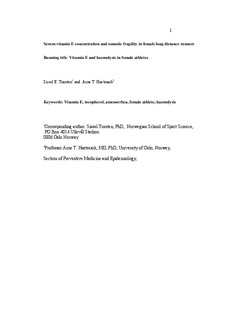| dc.contributor.author | Tomten, Sissel Erland | |
| dc.contributor.author | Høstmark, Arne Torbjørn | |
| dc.date.accessioned | 2010-01-14T11:59:45Z | |
| dc.date.issued | 2009-01 | |
| dc.identifier | Seksjon for fysisk prestasjonsevne / Department of Physical Performance | |
| dc.identifier.citation | Journal of Sports Sciences. 2009, 27(1), 69-76 | en |
| dc.identifier.issn | 0264-0414 | |
| dc.identifier.uri | http://hdl.handle.net/11250/170555 | |
| dc.description | I Brage finner du siste tekst-versjon av artikkelen, og den kan inneholde ubetydelige forskjeller fra forlagets pdf-versjon. Forlagets pdf-versjon finner du på www.informaworld.com: http://dx.doi.org/10.1080/02640410802448756 / In Brage you'll find the final text version of the article, and it may contain insignificant differences from the journal's pdf version. The original publication is available at www.informaworld.com: http://dx.doi.org/10.1080/02640410802448756 | en |
| dc.description.abstract | The objective of this study was to assess the nutritional adequacy of sub-elite runners with irregular menstrual function (n = 10) and that of a comparable group of runners with regular menstrual function (n = 10), with a special focus on vitamin E. Based on 3 days' records of weighed dietary intake, the mean energy intakes of micro- and macronutrients were estimated. Both estimated daily energy intake (irregular: 9.9 +/- 0.4 MJ; regular: 12.2 +/- 0.7 MJ; mean +/- s(x)) and intake of dietary fat (irregular: 61 +/- 6 g; regular: 98 +/- 12 g) were lower in athletes with irregular menstrual function than in athletes with regular menstrual function (P = 0.01). Estimated intake of vitamin E was below recommended values in both groups. Serum concentrations of alpha-tocopherol were used to evaluate vitamin E status, which were normal in athletes with regular menstrual function (27.3 +/- 3.6 mu mol . 1(-1)) but below normal values in athletes with irregular menstrual function (15.7 +/- 0.8 mu mol . 1(-1); P = 0.01). Furthermore, post-exercise osmotic fragility in red blood cells was inversely related to resting alpha-tocopherol concentrations. Our results indicate that irregular menstrual function in athletes on a low-fat diet is associated with low concentrations of circulating alpha-tocopherol, rendering the red blood cells more susceptible to haemolysis in connection with physical activity. | en |
| dc.format.extent | 164920 bytes | |
| dc.format.mimetype | application/pdf | |
| dc.language.iso | eng | en |
| dc.publisher | Routledge | en |
| dc.subject | vitamin E | en |
| dc.subject | tocopherol | en |
| dc.subject | amenorrhoea | en |
| dc.subject | female athletes | en |
| dc.subject | haemolysis | en |
| dc.title | Serum vitamin E concentration and osmotic fragility in female long-distance runners | en |
| dc.type | Peer reviewed | en |
| dc.type | Journal article | en |
| dc.subject.nsi | VDP::Social science: 200::Social science in sports: 330::Other subjects within physical education: 339 | en |
| dc.source.pagenumber | 69-76 | en |
| dc.source.volume | 27 | en |
| dc.source.journal | Journal of Sports Sciences | en |
| dc.source.issue | 1 | en |
